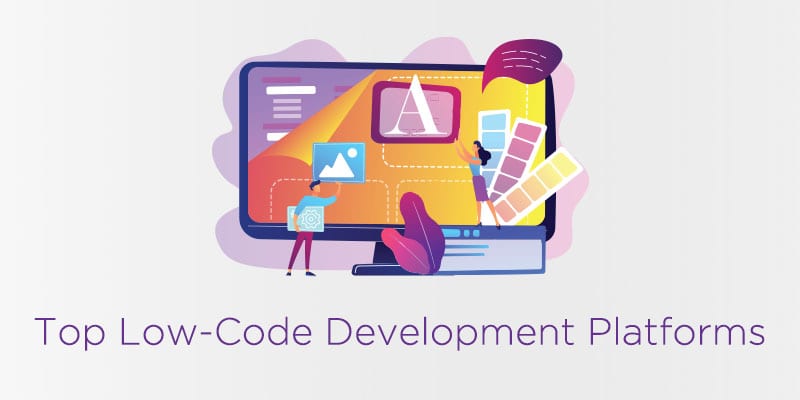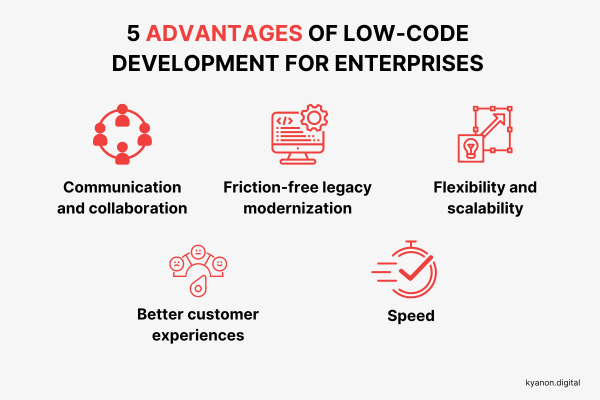New Facts For Deciding On Low-Code Platform Sites
New Facts For Deciding On Low-Code Platform Sites
Blog Article
Speed-Wise Low-Code Applications Have Many Advantages.
Visual Development Environment :
Drag-and-Drop Interfaces: Low-code platforms provide visual tools for designing applications. Drag-and-drop elements can be used by developers to build apps quickly with no code.
Many low-code platforms have pre-built templates or components that allow developers to quickly build prototypes of their applications and build applications without starting from scratch.
Reduction of Coding Requirements
Automated Code Generation Low-code platforms automatically create the underlying code based on the visual models developed by the developers. This eliminates the requirement for manual coding and improves the speed of development.
Reusable Parts: Developers will be able to reuse reusable components across projects and reduce the time needed for writing and testing of code.
Collaboration can be streamlined.
Low-code development platforms are typically equipped with tools like deployment, version control, and testing. This allows for seamless collaboration between teams.
Citizen Development (Citizen Development) Developers and users of business applications can take part in application development using intuitive interfaces. This helps to reduce the burden caused by a lack of professional developer availability.
Rapid Iteration, Prototyping:
Fast Prototyping Developers can quickly build prototypes for ideas to be validated and feedback collected and analyzed, which leads to faster iterations.
Easy Modifications – The visual nature low-code application development allows for easier changes and updates which speed the process of refining applications based upon user feedback.
Pre-built Integrations:
API Integrations Low-code platforms have prebuilt connectors that are compatible with the most popular APIs or services. They cut down the time it takes to integrate external applications.
Data Integration: Inbuilt instruments for data integration make it easier to process of connecting databases and other data sources which speeds up the development process.
Deployment and Scaling
One-Click deployment: A lot of platforms using low-code provide a one-click option for deploying applications, which can reduce the amount of time and effort.
Cloud-Based Platforms: Cloud-based platforms which are low-code allow for the management of infrastructure and scaling, meaning developers can concentrate on the the logic and performance of their applications instead of the logistics of deployment.
The efficiency of developing low-code applications lies in its ability simplify and automate a number of aspects of the app development. This allows for faster delivery of applications and faster adaption to the changing demands. Have a look at the top rated next page on Low-code Platform for application development for site tips including stored sql procedures, develop web app, app dev platform, rapid application design, app platforms, database in azure, mobile app development platforms, application modernization software, rapid action development, paas service and more.
The Benefits Of Low-Code Development For Governance And Security
Low-code app development provides several advantages in terms of governance and security. It is crucial to ensure that applications conform to laws, are safe and well-managed over their lifespan. Here are the benefits of low-code application development:
Unified Management Console - Low-code platforms have a central administration console that allows administrators to control and supervise every application. This ensures consistent governance across the entire organization.
Role-Based Access Control RBAC : These platforms typically include roles-based access controls, which allow administrators define and enforce rules. This allows only authorized users to change or access specific areas of the program.
Compliance and Regulatory Adherence
A lot of low-code platforms have integrated compliance features. For example, they are built in line with the standards of the industry, regulations and laws (e.g. HIPAA, GDPR). They have frameworks and tools which help ensure that apps meet the requirements of these regulations.
Audit trails and logging: Comprehensive audit trails and logging can be combined. This allows organizations to keep track of changes and access and also ensure compliance with internal regulations as well as external regulations.
Additional Security Measures
Data encryption. Low-code platforms offer encryption for information both in the state of rest and while it is being transmitted and ensures that sensitive information is kept safe.
Security Certifications Many low-code sellers have security certificates (e.g. ISO 27001, SOC 2 ) that demonstrate compliance with high security standards. This provides additional assurance for the customers.
Automated security Updates
Regular security updates and patches : Low-code platform handle automatically security patches, updates and updates. Applications are therefore protected from the latest threats without requiring the intervention of developers manually.
Security Monitoring: Continuous monitoring of security tools are typically provided, providing real-time alerts and insights into security concerns that could be a problem.
Data Governance
Data Access policies These platforms assist organizations establish and enforce their data access policy to ensure that only authorized users are able to access data and that it is correctly used.
Data Masking and Anonymization Tools built in for data masking & anonymization ensure the security of sensitive information, especially in development environments and testing environments.
Consistent Lifecycle Management of Applications
Pipelines for Development and Delivery Low-code platforms typically include integrated development pipelines as well as delivery pipelines that incorporate security checks. Security is assured throughout the lifecycle.
Version Control: An integrated version control enables the management of changes. It also guarantees that all modifications to the software are recorded, and if required, reversed. This is to ensure the integrity of the software.
User Authentication and Authorization:
Single Sign-On (SSO): Support for single sign-on and other advanced authentication methods makes managing users easier and increases security.
Multi-Factor Authentication - Many platforms can support multi-factor Authentication, which adds an extra layer to security when logging into applications.
Policy enforcement and Compliance monitoring:
Low-code platforms usually come with templates for policies that are pre-defined to enable organizations to implement cybersecurity and governance policies quickly.
Compliance Monitoring Tools The tools offer constant monitoring and reports about compliance levels, making it much easier to spot and fix potential issues proactively.
Integration with Existing Security Infrastructure
Seamless Integration: Platforms using low-code are built to integrate seamlessly with tools and infrastructure such as SIEM (Security Information and Event Management solutions) and firewalls.
API Security: API security features which protect data and maintain the integrity of the application are integrated into the API.
Training and best Practices
Many platforms offer guides and best practice for secure application development. They help non-developers meet security standards.
Some lowcode providers offer tools and security education for users to learn how they can build and maintain secure applications.
Overall the security and governance benefits of low-code development assure that the applications are developed and managed in a secure and compliant method. These platforms offer the frameworks and tools required to safeguard sensitive data and enforce policies while maintaining regulatory compliance. Have a look at the top Enterprise application development with Low-code Platform url for website info including cross platform mobile app development, rapid applications, app development platform, stored sql procedures, rapid action development, mobile app development platforms, ms azure sql, mobile development platforms, rapid action development, rad application development and more.
The Benefits Of Low-Code Development For Community Members And Vendors
Low-code platforms offer significant advantages in terms of community support and vendor support Both of which are crucial to the success in the implementation, maintenance, and further improvement of applications. Here are a few major benefits: Support from vendors
Comprehensive Technical Support:
Support Teams: Most platforms that use low-code provide special support teams that assist with technical problems, troubleshooting and guidance.
Help is accessible 24/7. Numerous vendors offer round-the-clock support that can be especially helpful for businesses operating in different time zones.
Training and onboarding:
Vendors typically offer user-friendly programs including tutorials or webinars. They can also offer certification courses.
A lot of vendors offer personalized onboarding that helps customers to make use of their platform effectively and customize it to meet their needs.
Regular Updates & Enhancements
Continuous Improvement Platform vendors typically release regular updates with new features, performance improvements and security patches. This is a way to ensure that the platform remains up-to-date and secure.
Feedback integration: Vendors will often incorporate user feedback into their development cycle to ensure that the platform meets the evolving needs of the users.
Comprehensive Documentation:
Comprehensive Documentation: A comprehensive and well-organized documentation is usually available, covering everything from the basics of use to advanced customization, which assists users in finding solutions on their own.
API References: The detailed API documentation helps developers integrate the low-code platform into other systems and customize their applications effectively.
Professional and Consulting Services
Expert Consultation : Vendors provide consultancy services, including architecture design and complex implementations. They provide this service to ensure that users can take full advantage of the platform.
Custom Development: Certain vendors offer services that allow them to develop specific features or the features, but they aren't available from the beginning.
Community Support
Active User Community:
Discussion boards and forums: Many low-code platforms offer vibrant online communities for users to exchange ideas, ask questions and collaborate.
User Groups and Meetups: Both local and virtual meetings and groups of users give you the chance to study, network, and share experiences with others.
Knowledge Sharing and Collaboration:
Community-Contributed Resources: Users often share templates, modules, and extensions that they have developed, which can be reused or adapted by others, accelerating development and innovation.
Crowdsourced Solution Finding: The collective experience and wisdom of a group can be a valuable resource in finding solutions to complex problems.
Learning and Development
Community-Led Training: Several communities hold workshops, training sessions, and webinars. They are often run by knowledgeable users who share practical knowledge and more advanced methods.
Online Tutorials & Courses: The community members frequently make online tutorials, courses, and guides on how to accomplish things, which enhances learning resources.
Feedback and Influence
Product Feedback: Several community forums offer channels to give feedback to the vendors. This could influence the development of the development of new features and enhancements.
Beta Testing Active communities could be able to be part of the beta testing process. This gives them early access to the platform and be involved in the creation of the platform.
Recognition and Support
Many vendors have community recognition programs, like MVP programs (Most Valuable Professional) that recognize the contributions of members who are active in their respective communities.
Peer Support. Community members offer peer-to-peer support. They offer their expertise with users who are less familiar and offer guidance. This creates a community of support and collaboration.
Overall, the combination of strong support from the vendor with a vibrant and active community provides an extensive support ecosystem for the development of low-code applications. The combination of strong vendor support and a vibrant, engaged community provides an entire support network for low-code development.